
The Countess’ Room and the ghosts of Dartington Hall
Every old house has its fair share of ghost-stories, chilling tales that are handed down through the generations, told and re-told by the fireside on dark winter nights. Dartington Hall, with its long and rich history, is no exception.
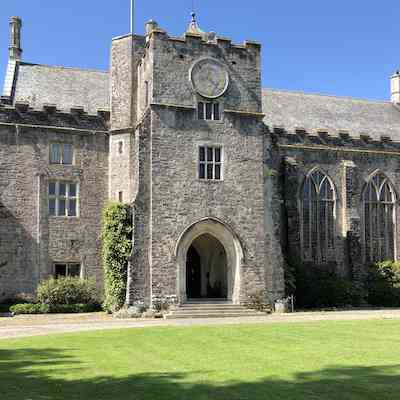
People have lived here amongst the rolling Devon hills since ancient times. One notable family, the Champernownes, made their home here for three hundred and sixty-six years.
Sir Arthur Champernowne, Vice Admiral of the Fleet of the West, brother of Queen Elizabeth’s childhood governess, Kate Astley, acquired the estate in the 1550s and his descendants owned Dartington until 1925. Over the years, the family cherished several ghost-stories about their home.
I’m especially interested in one of them. It concerns ghostly goings on in a room, traditionally known as the ‘Countess’ Room, which takes its name from Isabeau, Countess of Montgomery.
Isabeau de la Touche, a French Huguenot noblewoman, found refuge at Dartington during the French Wars of Religion. Her husband, Gabriel de Lorges, Count of Montgomery, gained fame as the man who killed King Henri II of France in a jousting accident in 1559. After converting to the Protestant faith, Gabriel became a prominent Huguenot general. Gabriel and Isabeau's daughter, Lady Gabrielle Roberda Montgomery, known as Roberda, came to England in 1571 to marry Sir Arthur’s son, Gawen. I've become fascinated by this young woman and the challenges she faced as a newcomer in Elizabethan England and I tell her story in my historical novels, The Dartington Bride and Mistress of Dartington Hall.
Sir Arthur Champernowne welcomed Roberda’s entire family to Dartington as refugees after they escaped the St Bartholomew’s Day massacre in Paris in 1572. Gabriel eventually returned to France to continue to fight for the Protestant cause. Isabeau remained at Dartington for some years.
My Search for the Countess’ Room
As a historical fiction author, I strive to bring people from the past to life and take my readers into their world. Visiting the places they knew is a vital part of my writers’ research. While I was crafting Roberda’s story, I was determined to find the room named for her mother.
At first I could find no-one at Dartington who remembered the Countess’ Room or knew where it was. I eventually traced it with the help of a labelled archive photo from the 1930s.
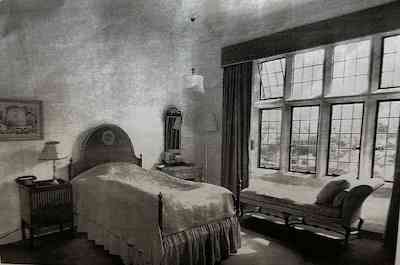
The Dartington Trust kindly let me explore ‘behind the scenes’ to see the room for myself. I found it in a part of the house remodelled by Sir Arthur after he took up residence in the late 1550s. In this photo you can see the window of the Countess' room, three stories up on the right, partially obsured by branches.
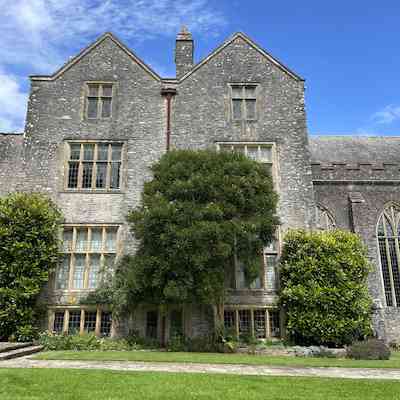
When I visited, the house was being refurbished. I found the Countess' Room an almost empty shell, with few furnishings; just a desk, some office chairs, and a tangled mess of cables. I tried to imagine how it looked in the sixteenth century. There would have been a fourposter bed with colourful embroidered hangings, oak coffers topped by vivid turkey rugs, perhaps a stool or window-seat with colourful tapestry-upholstered cushions.
From the window, although the gardens have changed over time, it was much easier to imagine the view that greeted Isabeau’s eyes; an Elizabethan knot garden with trimmed hedges laid out in intricate patterns and beds of herbs and flowers where silk-clad ladies strolled along gravel paths, while gentlemen took their exercise on a nearby bowling green. In the distance, a wooded hillside would have provided a vibrant green backdrop.
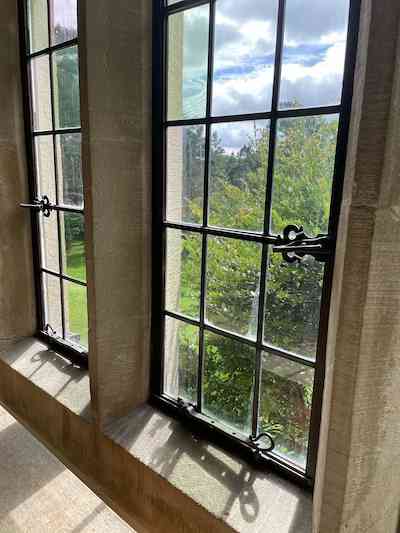
As I gazed from the window, lost in thought, images of Sir Arthur and his nephew Sir Walter Raleigh danced before my eyes. Until suddenly a cloud covered the sun and an icy shiver ran up and down my spine. Was it just my excitement at finding the Countess’ Room at last, the realisation that I was standing in the very spot where Isabeau and Roberda once stood? Or does some essence of those two women linger there? Is that why ghost stories are associated with this room?
***
Family Traditions and Memories
My further research proved fascinating. In particular, a report amongst the proceedings of the Devonshire Association which shed light on some of the family traditions.
The Champernownes’ fortunes had dwindled by 1925, and the buildings and grounds at Dartington Hall had become dilapidated and run down. The Champernownes sold the estate to Dorothy and Leonard Elmhirst who established the ‘Dartington Experiment’, an extraordinary pioneering enterprise, bringing together the arts, culture, farming, forestry and educational projects.
In 1959, while Leonard Elmhirst was president of the Devonshire Association, the Association’s Folklore Committee invited Miss C. Elizabeth Champernowne and her sister to share their thoughts on the many ghost-stories of Dartington. They started with the Countess’ Room.
Miss Champernowne acknowledged that family stories mentioned unexplained happenings in that room, and associated them with Gawen Champernowne and his French wife. Some versions of the story even suggested the Gawen's wife jumped from the window to her death.
In 1959, Miss Champernowne told the Folklore Committee she had never experienced strange goings on in the Countess’ room. However, she said that her mother, while seated there, once heard someone walking across the floor of the nursery above. Believing it to be the nursemaid, she spoke to the woman in charge of the nursery the next day. She intended to give instructions that the maid should not to stay up so late. However, she was told that the girl had been terrified by a mysterious incident. According to the nursery maid, the previous evening a woman had walked into the room, burnt a piece of paper in the fire, and gone out again without speaking.
Miss Champernowne’s sister also recalled that, when she was a child, an ancient lady would come into the room and lean over her bed. A brother had told her he had a similar experience.
Perhaps the nursemaid and the children were dreaming, but her story concerns the room over the Countess’ room. Is it fanciful to imagine that the nursery maid saw Isabeau’s ghost burning the letter that bought such evil tidings of her husband’s death? the chirldren slep in that same room, above the Countess' Room. Was Isabeau the woman in white the children remembered? Or could the footsteps be echoes of Roberda's feet on the floorboards?
I've yet to find any record of when or where Roberda died. After Gawen's death she remarried and lived at Cloford in Somerset, so it is unlikely she died at Dartington. I've found no evidence of anyone jumping from a window. An alternative version of the story is that the Countess herself haunts the room. Isabeau did not die at Dartington, but at Pontorson, in France in 1593. However, it’s likely she was at Dartington, perhaps in that very room, on the day she received the appalling news of her husband’s execution. Could she have left some imprint of her intense anguish at Dartington?
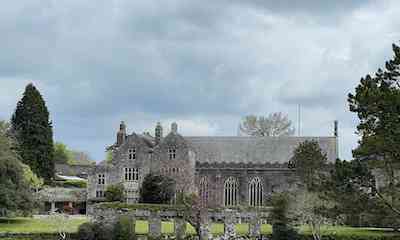
Other Strange Events and Apparitions
The White Lady
The sisters mentioned a family traditon that just before someone was going to die a lady in white was supposed to appear.
Miss Champernowne’s sister remembered a vivid dream she had in 1889. She dreamt a woman in white was sitting on the front stairs with her head in her hands. Three weeks later, her brother Henry, who was in the army, died in India. Apparently, before his death, he had been trying to get a message back to his mother.
On another occasion, in 1890, a maid saw a lady in white walking across the lawn. Three weeks later, Richard Champernowne, the rector of Dartington, died.
The Scattered Papers
On the day Leonard Elmhirst concluded his purchase of the estate, Miss Champernowne’s sister climbed up the tower stairs to the small ‘Steward’s room’ and found papers scattered all over the floor. She replaced the documents, estate bills from the eighteenth century, in the pigeonholes covering the walls, wondering what had caused them to blow about the room. When she shared the story with her cousin, Mr Martin, the rector, he mentioned a similar incident with the same set of papers. Again, there was no explanation for their scattered state.
Could it be that they were unpaid bills and a ghostly creditor was demanding payment before the Champernowne’s left?
The Piano with no Pianist
The sisters both remembered on several occasions hearing exquisite piano playing coming from the drawing room, but found the door locked from the outside and the room empty. When they told their mother, she said it was extraordinary, since her own mother (the girls’ grandmother) also used to hear piano playing.
The Headless Horseman
Perhaps the most scary story of all is that of the Headless Horseman. The sisters remembered the old steward telling a tale about a frightening figure with no head, who galloped through the lowest gate in the drive, close to the river.
Many people have ridden in those woods. The Norman lords who held the land after 1066 left their mark on the landscape. In the early fourteenth century, Nicholas Fitz-Martin was granted the right of free warren at Dartington, and by 1326, he had enclosed a deer park covering some 100 acres. With his huntsmen, no doubt Nicholas often frequented the woods near the river, where the headless horseman was supposed to appear.
In the late fourteenth century, Richard II granted the estate to his half-brother, John Holand, Earl of Huntingdon, later Duke of Exeter. John built a magnificent hall fit for royalty, with courtyard accommodation for his retainers. But in January 1400, he took part in the ‘Epiphany rising,' a failed rebellion against Richard’s cousin, King Henry IV, who had taken the throne. The uprising failed and John Holand was beheaded. His execution happened far from Dartington, at Pleshey Castle in Essex on 9 January 1400. His head was placed on London Bridge and his body buried in the Collegiate Church at Pleshey.
Of course, many ancient places have tales of headless horsemen. Perhaps the old man was just having fun, telling frightening stories suitable for Halloween. Perhaps he was borrowing a tale he had heard attached to some other property. Or could it be that the ghost of some long dead Champernowne, John Holand himself, or Nicholas Martin’s medieval huntsman rides headless through the woods? Who can say?
Rosemary Griggs
October 2024
(edited July 2025)
If you've enjoyed this post please sahre on social medai using the links below
